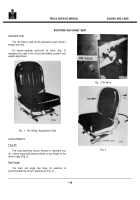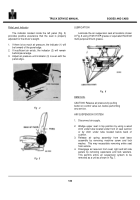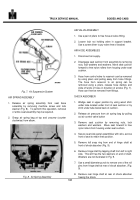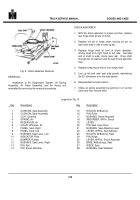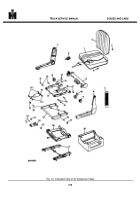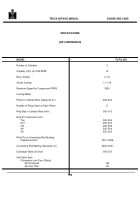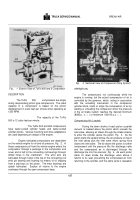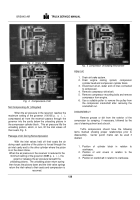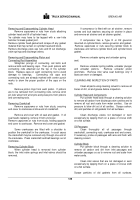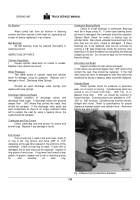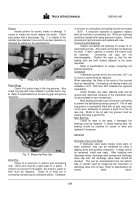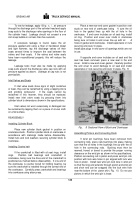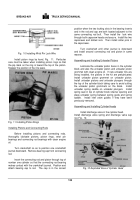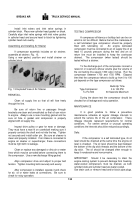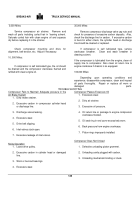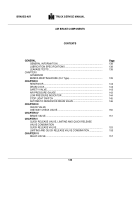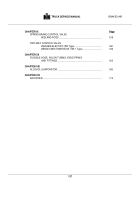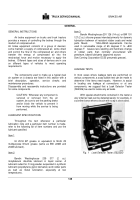TM-5-3805-254-14-P-2 - Page 131 of 894
TRUCK SERVICE MANUAL
BREAKS-AIR
Removing and Disassembling Cylinder Head
Remove capscrews or nuts from studs attaching
cylinder head and lift off cylinder head.
’he cylinder may have to be tapped with a raw hide
hammer to break gasket joint.
Remove cylinder head gasket and scrape off any gasket
material that may remain on cylinder head and block.
Remove discharge valve cap nuts and lift out discharge
valve springs and discharge valves.
Removing and Disassembling Piston and
Connecting Rod Assemblies
Straighten prongs of connecting rod bolts and
remove bolts and bearing caps.
Then push pistons with
connecting rods attached out the top of the cylinder
block.
Replace caps on each connecting rod to avoid
damage to bearings.
Connecting rod caps and
connecting rods are already marked with center punch
marks to show the proper position of the caps on the
rods.
Remove piston rings from each piston.
If pistons
are to be removed from connecting rods, remove wrist
pin lock wires from wrist pins and press pins from pistons
and connecting rods.
Removing Crankshaft
Remove capscrews or nuts from studs, securing
end cover to crankcase at drive end of crankshaft.
Remove end cover with oil seal and gasket.
If oil
seal needs replacing, remove it from end cover.
Remove capscrews or nuts from studs, holding opposite
end cover to crankcase.
Remove end cover and gasket.
Some crankcases are fitted with a shoulder to
position the crankshaft in the crankcase.
In such cases
the crankshaft may be removed only through one end of
the crankcase.
Press crankshaft and ball bearings out of
crankcase.
Removing Cylinder Block
When cylinder head is removed from cylinder
block, the inlet valve springs and inlet valves should be
removed.
If compressor is fitted with an air strainer, remove
screws and lock washers securing air strainer in place
and remove air strainer and air strainer gasket.
If compressor has a Type D or D2 governor
mounted on cylinder block, remove governor and gasket.
Remove capscrews or nuts securing cylinder block to
crankcase and remove cylinder block and cylinder block
gasket.
Remove unloader spring and unloader spring
seat.
Remove unloader spring saddle, unloader plunger
and unloader pistons.
Remove unloader piston
grommets.
Remove inlet valve seat bushings only if
seats are worn or damaged.
CLEANING AND INSPECTION OF PARTS
Clean all parts using cleaning solvent to remove all
traces of dirt, oil and grease before inspection.
Cylinder Head and Components
Put cylinder head body through a cleaning solution
to remove all carbon from discharge valve cavities and to
remove all rust and scale from water cavities.
Use air
pressure to blow dirt out of all cavities.
Scrape carbon,
dirt, and particles of old gaskets from all surfaces.
Clean discharge valves not damaged or worn
excessively by lapping them on a piece of crocus cloth
on a flat surface.
Oil Passages
Clean thoroughly all oil passages through
crankshaft, connecting rods, crankcase and end covers.
If necessary, probe oil passages with wire and flush with
cleaning solvent.
Cylinder Block
Put cylinder block through a cleaning solution to
remove all carbon and dirt from inlet passages and
unloader passages so as to remove rust and scale from
water cavity.
Clean inlet valves that are not damaged or worn
excessively by lapping them on a piece of crocus cloth
on a flat surface.
Scrape particles of old gaskets from all surfaces.
129
Back to Top

